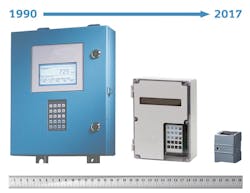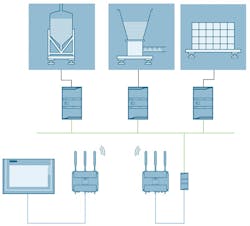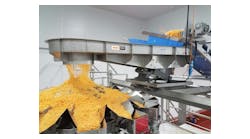Modern weighing instruments offer flexibility in integration and application
The history of weighing dates back to the Bronze Age more than 4,000 years ago when merchants used scales to sell their products. It was more practical at that time to sell in bulk instead of in individual pieces. The earliest generations of scales, appropriately called balances, used a beam balanced on a fulcrum. The unknown weight was suspended on one side of the beam and a known reference weight was suspended from the other side of the beam. When the beam was horizontal, the weights were equal.
No significant advancements were made to weighing technology until the Industrial Age in the 18th century when the spring scale was invented. This eliminated the need for counter weights. Then the invention of the bonded strain gauge load cell in the early 1940s allowed weight to be measured electronically. Today’s modern scales come in a variety of types and capacities from industrial scales for measuring train cars to ultra-precision scales used in laboratory environments.
As scale technology has improved, the applications scales can be used in has increased. In industrial environments, strain gauge load cells can be used to measure weight in a wide range of applications.
Application flexibility
Although platform scales, truck scales and track scales remain common in most industrial environments, today’s modern scales are being used in applications such as bin weighing and conveyor belt scales.
Bin weighing systems put an entire bin or hopper on load cells to measure the mass of the material in the bin or hopper. In some applications, the bin will be emptied through a small screw conveyor. As the material is drawn from the bin by the screw conveyor, the amount of material is measured and the rate the material is pulled from the bin is calculated. This type of system is called a loss-in-weight system. The output of the weighing instrument on a loss-in-weight system will be used to control the speed of the screw conveyor so the material is drawn from the bin at a desired rate. This type of system can be used to control the rate of material going into a process or for continuous blending where multiple components will be blended without having to stop the material flow. Although bin weighing systems and loss-in-weight systems are both measuring the amount of material in a hopper or bin, different electronics are used for these two applications. The loss-in-weight system requires additional functionality to calculate the flow rate of the material as it is drawn from the bin and requires the ability to control the screw conveyor.
Figure 1. The electronics for a belt scale system in the 1990s used a large single-purpose electronics package over 1 foot wide and nearly 1.5 feet tall. A belt scale weighing module today is less than 3 inches wide and 4 inches high.
Another weighing application commonly found in industry is used for batch processes. A batching process is the mixing of several ingredients in exact proportions. In a batch weighing system, a blending tank or hopper is placed on load cells. Each component of the blend will be added individually. As the correct amount of material is delivered to the tank or hopper, the output of the batch scale instrument will stop the flow of material into the hopper or tank. A batch weighing instrument will normally have the ability to slow the flow of material as it approaches the desired amount, allowing the system to provide very accurate blends of materials.
Similar to a batching scale, filling scales require the ability to slow the material flow as the weight approaches the set point. Filling scales are used to fill individual packages. These packages can range from individual soda bottles to bags of cement. In this type of application, an empty container is placed, either by hand or with a transport system, on a platform supported by one or more load cells. As the package fills, the weighing instrument will stop the flow of material when the package contains the desired weight. As mentioned previously, a filling scale will have outputs to slow the flow rate as the weight of the package approaches the desired amount.
Modern scale systems are also used to measure material as it is transported on a conveyor. Checkweighing systems measure the weight of individual pieces or packages as they are transferred by a conveyor. Checkweighing systems typically use a short conveyor that has a plate mounted on a load cell under the carrying side of the belt so the belt rests on the deck. The scale will use a photo eye or similar device to determine when the package is completely supported by the weighing deck. After it is determined that the object or package is completely on the weighing deck, the scale will make a measurement.
Figure 2. Several weighing modules for several applications can be set up to communicate with one HMI for users. This link can be made via a standard communications bus, which can be hardwired or configured across a wireless network as shown.
Conveyor belt scales measure bulk material such as grain or aggregate as it is moved by conveyor. A conveyor belt scale uses load cells mounted under one of the carrying idlers on the conveyor. With a conveyor belt scale, a speed sensor is used to measure the speed of the belt. The electronics for a belt scale will use the weight on the load cells and the speed of the conveyor from the speed sensor to calculate an instantaneous flow rate and the accumulated total amount of material that has been transferred across the conveyor. Although both scales measure product on a conveyor, they require different instruments to make the measurement. The instrument for a checkweigher will require a method to determine when the object is completely on the scale and make a discrete weight measurement. The instrument for a conveyor belt scale will require the ability to combine the signals from the load cell and speed sensor and continuously calculate the amount of material being transferred on the conveyor.
These are just a few ways modern industry uses scales to improve processes. In most cases, the electronics for weighing will be designed for one or two specific types of applications. For example, the weighing electronics for a bin weighing system are different from the electronics used for a conveyor belt scale. In some cases the measurement may be similar; however, the electronics have built-in algorithms that are tailored for that application.
Integration flexibility
In recent years, scale electronics have evolved from large, single-use weighing instruments to small weighing modules (see Figure 1). Now small size and interface flexibility allows modules for different applications to be combined in one enclosure with one user interface and one output to the control system.
These weighing modules are often designed so they can operate without a programmable logic controller (PLC) or directly on the backplane of a PLC to allow for seamless integration into the PLC. Whether used with or without a PLC, several modules for several applications can be set up to communicate with one human machine interface (HMI) for users. This link can be made via a standard communications bus, which can be hardwired or configured across a wireless network as shown in Figure 2. Many scale applications require control of other control devices such as drives or sensors. In these applications, operating the scale directly on the backplane of the PLC eliminates the need for a separate HMI to access the scale because the scale can be accessed through the HMI on the PLC. Also, because the scale and the PLC are the same technology, integrating the scale electronics directly into the PLC allows common technology for other components such as wiring and electromagnetic compatibility (EMC) shielding.
Configuration flexibility
In addition to being able to be configured through a PLC or HMI, most modules have software that allow the them to be configured by a computer. The flexibility allows users to select a method of setup that best suits their resources.
Weighing instruments have become increasingly flexible over the years. Their smaller size and increased communication capabilities make them versatile in modern manufacturing processes.
John Dronette is the product marketing manager for all Weighing Technology and Process Protection products at Siemens. He has been with Siemens and Milltronics for 21 years.





